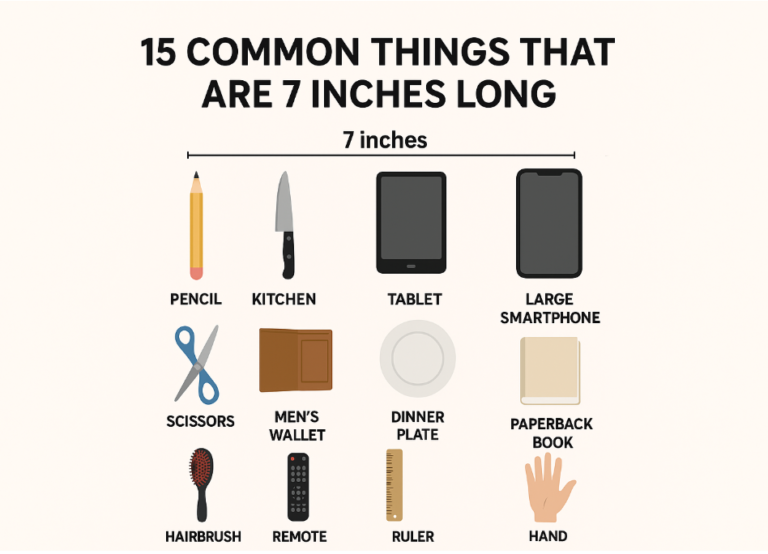Things That are 2 Millimeters Long: 9 Common Things

Things That are 2 Millimeters Long include Rice grains, Pinheads, Poppy seeds, Small screws, Ants, Fleas, Ticks, Dust mites, and Aphids.
The world is filled with objects of varying shapes and sizes, each with its unique dimensions.
Some things are so small that they often escape our attention, yet they play a crucial role in our daily lives.
One such measurement that often goes unnoticed is 2 millimeters. It’s astonishing how much can be packed into this tiny length.
Here, we will delve into the world of things that are 2 millimeters long, providing a guide to understanding this measurement, measuring it accurately, and discovering common objects that share this diminutive size.
How Long Are 2 Millimeters? – A Guide to Measuring 17 Feet
Before we dive into the intriguing world of objects that measure 2 millimeters in length, let’s first grasp the concept of this measurement.
To put it simply, a millimeter is one-thousandth of a meter.
To visualize this better, imagine dividing a meter into 1,000 equal parts; each of those parts is a millimeter.
Two millimeters, then, would be equivalent to 0.002 meters.
To provide a more relatable comparison, it’s about the thickness of a nickel or the diameter of the tip of a sharpened pencil.
It’s such a minuscule unit of measurement that it’s often challenging to appreciate without a frame of reference.
To make the concept of 2 millimeters more tangible, let’s consider a standard height: the average human, standing at around 5 feet 7 inches (approximately 170 cm).
Now, if we were to lay out 2-millimeter objects end to end, it would take a staggering 8,500 of them to span the length of just one foot.
To stretch this to 17 feet, you would need a jaw-dropping 144,500 of these tiny objects lined up consecutively.
The equivalent length of 2 Millimeters in various units of measurement
| Measurement Unit | Equivalent Length of 2 Millimeters |
|---|---|
| Millimeters (mm) | 2 mm |
| Centimeters (cm) | 0.2 cm |
| Meters (m) | 0.002 m |
| Inches (in) | 0.0787 in |
| Feet (ft) | 0.0066 ft |
| Yards (yd) | 0.0022 yd |
| Kilometers (km) | 0.000002 km |
| Miles (mi) | 0.0000012 mi |
| Astronomical Units (AU) | 0.000000000000026 AU |
Measuring 2 Millimeters Accurately
Measuring something as small as 2 millimeters requires precision and the right tools. Here are some common methods for accurate measurement:
Vernier Calipers
These specialized tools provide precise measurements down to the millimeter.
They consist of two jaws that can be adjusted to fit the object being measured.
The main scale and vernier scale allow for readings with high accuracy.
Micrometer Screw Gauge
A micrometer screw gauge is an even more precise instrument, capable of measuring objects to the nearest thousandth of a millimeter.
It’s often used in engineering and manufacturing.
Digital Calipers
These are modern versions of vernier calipers with a digital display for easy and accurate readings.
They are user-friendly and provide quick measurements.
Optical Comparators
Optical comparators use lenses and mirrors to magnify the object being measured.
This method is ideal for inspecting small parts with intricate details.
Microscopes
When dealing with extremely tiny objects, microscopes come to the rescue.
They can magnify objects significantly, allowing for precise measurements of minuscule features.
Laser Interferometers
In scientific and industrial applications, laser interferometers use laser beams to make incredibly accurate measurements in the nanometer range.
Scale and Magnifying Glass
For quick and rough measurements, you can use a millimeter scale along with a magnifying glass to ensure accuracy.
Reference Objects
In some cases, reference objects of known size, like coins or calibration standards, can be used to estimate the size of a 2-millimeter object.
Remember that the choice of measurement tool depends on the specific requirements of your task, the level of precision needed, and the size of the object being measured.
Things That are 2 Millimeters Long
When it comes to measuring the world around us, precision is key.
In the realm of small-scale measurements, 2 millimeters may seem insignificant, but it’s a dimension that encompasses a fascinating array of everyday objects.
From the tiny grains of rice in your kitchen to the minuscule creatures that inhabit the natural world, there’s an entire universe of things that are roughly 2 millimeters long.
In this exploration, we’ll explain nine common objects that fit this description, shedding light on their significance and the roles they play in our lives.
| Item | Length (Approximately 2 mm) |
|---|---|
| Rice grain | 2 mm |
| Pinhead | 2 mm |
| Poppy seed | 1-2 mm |
| Small screw | 2 mm |
| Ant | 1-3 mm |
| Flea | 1.5-3.3 mm |
| Tick | 1.5-3.3 mm |
| Dust mite | 0.2-0.3 mm |
| Aphid | 1-3 mm |
Please note that the sizes of some of these items can vary slightly, but they are generally close to 2 millimeters in length.
Rice Grains

Rice, a staple food for billions of people worldwide, comes in various shapes and sizes. Some rice grains measure approximately 2 millimeters in length.
While this may be small compared to other grains and cereals, rice grains are a crucial part of many cuisines and serve as a primary source of nutrition for a significant portion of the global population.
Pinheads

The common pin, a tiny yet essential tool, typically features a head that is roughly 2 millimeters in diameter.
Pins have been used for centuries in various applications, from fastening clothing to securing important documents.
The precision in manufacturing pinheads to this size showcases the skill and attention to detail of artisans throughout history.
Poppy Seeds

Poppy seeds, often used in baking and cooking, are known for their minuscule size. These small, round seeds average around 1-2 millimeters in length.
Despite their diminutive stature, they add a delightful crunch and a burst of flavor to a wide range of dishes, from bagels to pastries.
Small Screws

In the world of DIY projects, electronics, and manufacturing, small screws play a crucial role.
These screws can measure around 2 millimeters in length and are used to secure delicate components and materials.
Their small size is a testament to the precision required in industries that demand intricate work.
Ants

Ants are fascinating insects that come in various sizes and colors depending on their species.
Some ant species, such as the tiny Argentine ant, measure only about 2 millimeters in length.
Despite their small size, ants are social creatures that demonstrate remarkable teamwork and organization in their intricate colonies.
Fleas

Fleas are notorious for their ability to irritate pets and humans alike. These tiny parasites typically measure about 1-2 millimeters in length.
Their incredible jumping abilities, relative to their size, make them a formidable nuisance for many animals and their owners.
Ticks

Ticks are another arachnid that can measure around 2 millimeters in length.
These blood-feeding parasites can transmit diseases to both humans and animals, underscoring the importance of managing their populations and taking precautions when venturing into tick-prone areas.
Dust Mites

Dust mites are microscopic arachnids that thrive in household dust and bedding materials.
While individual dust mites are nearly invisible to the naked eye, they typically measure between 0.2 to 0.5 millimeters in length.
Their tiny size belies their potential to trigger allergies and asthma in some individuals, making them a significant concern for those with sensitivities.
Aphids

Aphids are small insects known for their ability to reproduce rapidly and feed on plant sap.
These creatures can range from 1 to 3 millimeters in length, with some species falling squarely within the 2-millimeter range.
Aphids are a common pest in gardens and agricultural settings, requiring careful management to protect crops and plants.
FAQ’s
1. Why are 2 millimeters a relevant measurement?
2 millimeters may seem small, but it’s a critical measurement in various industries, such as engineering, manufacturing, and healthcare. It’s often the difference between a perfectly functioning machine and a malfunction. Additionally, in medicine, surgical instruments, and implants are often measured in millimeters to ensure precision and safety.
2. What objects in our daily lives are approximately 2 millimeters long?
Many objects we encounter daily share this tiny length. Some examples include the thickness of a credit card, the width of a staple, and the diameter of a small button.
3. Are there any natural objects that are 2 millimeters in length?
In nature, countless small organisms, like certain insects and microorganisms, measure around 2 millimeters in length. These tiny creatures play crucial roles in ecosystems and can be fascinating to study under a microscope.
4. How can I measure 2 millimeters without specialized tools?
While specialized tools like vernier calipers and micrometers provide the most accurate measurements, you can approximate 2 millimeters using common objects. A paperclip, for instance, is about 2 millimeters wide when straightened. Comparing the object you want to measure with known references like this can give you a rough estimate.
5. Is 2 millimeters the smallest unit of measurement?
No, 2 millimeters is not the smallest unit of measurement. Measurements can go down to the nanometer and even smaller scales. Nanometers are one billionth of a meter, making them much smaller than millimeters.
6. What is the importance of precision when measuring 2 millimeters?
Precision is crucial when dealing with 2-millimeter measurements, especially in industries where small discrepancies can have significant consequences. Accurate measurements ensure the proper functioning of machinery, the safety of medical procedures, and the quality of manufactured products.
7. How can I convert 2 millimeters into other units of measurement?
You can convert 2 millimeters into other units using the table provided earlier. Simply multiply 2 millimeters by the conversion factor for the desired unit to get the equivalent length.
Conclusion
In the grand tapestry of the universe, even the smallest measurements like 2 millimeters hold significance.
Whether it’s the precision required for medical devices, the delicate parts of an intricate machine, or the subtle beauty of nature’s tiniest creatures, these humble millimeters play a pivotal role in our lives.
Understanding and appreciating the importance of this measurement is a testament to the precision and complexity that surround us.






